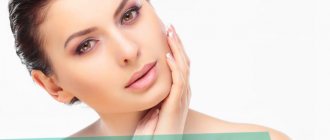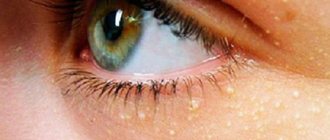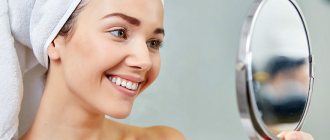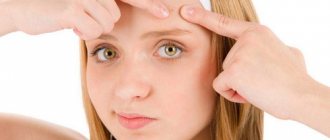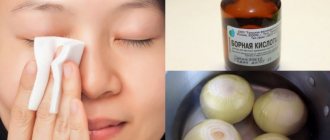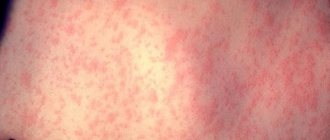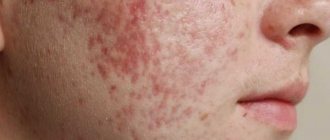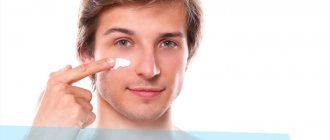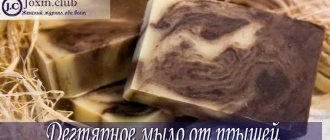Reasons for appearance
What causes blemishes on the face? Most often, milia, or milia, occur in infants.
White growths in newborns are normal.
, which occurs due to the growth of the baby’s internal organs.
They do not require special treatment, unlike similar formations in adolescents and adults.
The skin at this age is already fully formed, and the reasons for the appearance of millet grass are
could be the following things:
- Hormonal imbalance.
- Improper functioning of the digestive organs.
- Poor nutrition.
- Thyroid diseases.
- Lack of care or improper care of facial skin.
- Excessive exposure to the sun, frequent visits to the solarium.
- Poor quality of facial procedures.
- Skin diseases and burns.
- Use of low-quality decorative cosmetics.
- Frequent use of scrubs.
Millet patches can form during puberty, during pregnancy and after childbirth, as well as with problems with sex hormones.
You can learn how to get rid of blackheads on your face at home from our guide.
How to get rid of millet on your face?
If millet appears on your face, how to get rid of it?
Many people wonder: if millet appears on the face, how to get rid of it? This is a common problem that distorts the beauty of the skin. How to get rid of this scourge and prevent its occurrence in the future?
Is millet a disease or a cosmetic problem?
Often white or yellowish lumps appear on the face, very similar to whiteheads or pimples (this is millet, or milia). The formations are safe for health, do not lead to skin inflammation and do not cause pain, but are still a cosmetic problem. The areas of skin where millet has formed become rough and rough, which makes you want to remove these white bumps.
For a long time, there was a misconception that millet occurs due to blockage of the skin pores and the accumulation of sebum in it. But clogged pores lead to the appearance of comedones on the cheeks, forehead, chin and other places characteristic of the appearance of acne and pimples. When they are removed, the pores are cleansed of hardened fat with minimal or no damage to the skin.
Unlike whiteheads and blackheads, milia appear under a thin layer of skin at the mouth of the hair follicle. Thanks to modern research, it has been established that the capsule of the millet cyst consists of keratinized epithelial cells and a small amount of sebaceous gland secretion. Millet most often appears on thinner layers of skin: on the eyelids, cheekbones and temples, wings of the nose and near the lips.
Millet appears in people at any age, but most often newborn children and young women are susceptible to it. In almost half of newborns, white dots can be seen on the face, but they do not require treatment or removal and, as a rule, disappear without a trace during the first month of life. However, adults have to deal with milia, since in this case they very rarely resolve on their own and can remain on the skin for years.
The appearance of millet grains is due to a disruption in the skin renewal process caused by certain factors. Human skin is continuously renewed, and within 25-30 days, epidermal cells rise to the surface and must peel off. If the number of accumulated cells exceeds the norm, then they form a barrier that prevents the release of sebum. As a result of the accumulation of horny scales and the secretion of the sebaceous glands, in some cases inflammation occurs (classic acne), and in others - whitehead, or milia.
The exact cause of milia has not been established, but experts identify a number of factors that have a detrimental effect on the condition of the skin and can lead to the appearance of milia:
- Hormonal disorders.
- Improper skin care.
- Hyperkeratosis.
- Poor nutrition.
- Mechanical method.
- Curettage.
- Electrocoagulation.
- Laser removal.
- Skin care program.
- Diet.
Due to hormonal imbalances, the functioning of the sebaceous glands is very often disrupted, and the skin becomes oilier. Therefore, this cosmetic problem mainly worries teenagers and women during pregnancy and menopause.
The skin requires regular cleansing of accumulated horny scales, remnants of decorative cosmetics, dust and fat. Regular washing cannot rid the skin of impurities; it prevents the release of sebum and accumulates in acne. Intensive use of scrubs, on the contrary, leads to excessive formation of new cells, which accumulate and cause the formation of millet.
When a large number of cells accumulate, the stratum corneum of the skin grows, that is, hyperkeratosis. Skin injuries caused by burns, mechanical damage and even some cosmetic procedures can lead to the development of this disease.
Spicy, fatty, floury and high-calorie foods lead to intense work of the sebaceous glands and the production of more sebum.
There are primary and secondary milia. Primary millet grass occurs in people with a genetic predisposition and disappears on its own after a short time. Secondary milia are formed against the background of inflammatory and traumatic processes of the skin or skin diseases; they can grow and occupy larger areas. Secondary milimumi usually require removal.
Return to zmistWhat should be a safe treatment for millet grass?
Millet lesions rarely go away on their own, and it is almost impossible to get rid of them with the help of cosmetics. It is strictly forbidden to squeeze out whiteheads yourself, as this leads to damage to the hair follicles and sebaceous glands. Self-medication often aggravates the problem, leading to acne enlargement, inflammation and scar formation. To avoid these consequences, the removal of millet grasses should be carried out by a specialist.
Upon examination, a dermatologist easily makes a diagnosis and prescribes treatment aimed at removing milia and preventing their further occurrence.
In this case, the specialist recommends a treatment method, taking into account the individual characteristics of each patient.
Return to zmistWhat are the possible methods of treatment?
Today there are several methods that are used to remove millet:
The doctor or cosmetologist uses a sterile needle to puncture the head of the whitehead and extract its contents. In some cases, an incision is made instead of a puncture. After milia are removed mechanically, skin damage occurs, which must be treated with an antiseptic for several days after the procedure to prevent infection. This method can be used to treat blemishes on thicker facial skin; it is not recommended for use on the skin around the eyes.
Another tool for removing grass stains is a curette. Curettage is also a mechanical method of treatment, which leads to the formation of wounds and creates a risk of infection. Therefore, it is used much less frequently in cosmetology.
A fairly common method of removing whiteheads using local exposure to high-frequency alternating current. After the procedure, a crust appears at the site of the milium, which disappears on its own within a few days.
When removing grasses with a laser, there is absolutely no pain and no risk of infection. It is recommended to remove no more than 10 milia in one procedure to avoid unnecessary damage to the skin and sebaceous glands.
Return to zmist How to avoid the appearance of millet?
Preventive measures help protect the skin from the appearance of new formations after the treatment procedure. To do this, just follow a few recommendations:
The skin must be cleansed of dirt daily. To do this, it is enough to wash your face in the morning and evening using cosmetic makeup removers. Using an antiseptic toner or lotion rids the skin of sebaceous gland secretions and prevents the accumulation of sebum. To deeply cleanse the skin, it is recommended to use scrubs after preliminary steaming (no more than twice a week). Scrubs remove dead skin cells that prevent sebum from coming out. With this care, the natural process of skin restoration is normalized and the risk of breakouts is minimized.
Research shows that frequent consumption of fruits and vegetables and avoidance of fatty foods have a beneficial effect on the overall condition of the skin and solve many cosmetic problems. In the fight against millet, you should also adhere to a healthy diet.
You need to start solving the problem of millet by going to the doctor. Only a specialist will be able to prescribe the necessary treatment and recommend remedies that will help prevent the formation of acne in the future.
Treatment methods
How to remove millet on the face? What treatment can be offered at the salon?
Specialists in beauty salons and beauty salons will help you quickly and effectively get rid of milia without leaving scars or redness on the skin.
The most commonly used methods are laser removal and mechanical cleaning.
(squeezing),
electric current cleaning, special peeling, absorbable injections, vacuum
facial cleansing.
Important advice from the editors
If you want to improve the condition of your skin, you should pay special attention to the creams you use. A frightening figure - 97% of creams from well-known brands contain substances that poison our body. The main components due to which all the troubles on the labels are designated as methylparaben, propylparaben, ethylparaben, E214-E219. Parabens have a negative effect on the skin and can also cause hormonal imbalance. But the worst thing is that this nasty stuff gets into the liver, heart, lungs, accumulates in organs and can cause cancer. We advise you not to use products that contain these substances. Recently, experts from our editorial team conducted an analysis of natural creams, where first place was taken by products from Mulsan Сosmetic, a leader in the production of all-natural cosmetics. All products are manufactured under strict quality control and certification systems. We recommend visiting the official online store mulsan.ru. If you doubt the naturalness of your cosmetics, check the expiration date; it should not exceed one year of storage.
Contraindications and frequency of use
Masks containing potatoes or honey should not be used by girls and women with various forms of allergies.
Masks with cucumber, cosmetic clay and garlic can be used by almost everyone
. Masks containing alcohol solutions or bodyaga are not recommended for use more than once a week.
The product, which consists of lamb fat and onion juice, must be cooled before use.
. All other masks listed above are recommended to be used 2 times a week.
You can use two different recipes in the same week. For those with dry skin
It is better not to resort to citrus-alcohol lotion.
Efficiency
Most women who used homemade homemade masks or other folk remedies noted that the number of milia within a month of use was halved
, some formations disappeared without a trace.
Those with oily skin also noticed that their facial skin became more matte
.
The sooner you start treating millet, the faster and more effectively you can get rid of it. Maintaining the achieved results is very easy if you follow a certain diet
– limit sweets and starchy foods, eat fatty and artificial foods less often.
Vitamins A, B, and E will be excellent helpers for preventing the occurrence of such an unpleasant formation as milia.
For information about the causes and methods of treating millet on the face, watch the video:
Smooth, velvety and clean facial skin is considered the main factor determining the beauty and well-groomed appearance of a woman. However, numerous dermatological problems and diseases spoil the aesthetics of the face and cause a lot of problems for their owners.
One of the most “harmful” imperfections is millet, which is a white subcutaneous formation. This condition is also called milia and whiteheads. We will talk about what millet looks like, the reasons for its occurrence, proper treatment and preventive measures in today’s article.
Millet is a dermatological disease caused by clogging of pores with keratinized skin particles. Outwardly, it resembles a millet grain, which is how it got its name. The structure of the miluim is dense; inside the skin formation there is most often a yellowish or white mass consisting of dead skin and a small amount of fat. The size of whiteheads varies between 0.4-3 mm. Millet most often occurs near the eyes, on the nose and chin, but can also be located on other parts of the face and body. If milia is not treated, it will bother its owner for many years.
The reasons for the appearance of millet are as follows:
- Excessive activity of the sebaceous glands, improper care of the facial epidermis, prolonged exposure to sunlight;
- Disturbances in the functioning of sex hormones. This occurs during pregnancy, adolescence and menopause;
- Diseases of the digestive system, as well as unhealthy diet;
- Improper functioning of the pancreas and thyroid gland. Disturbances in the functioning of these organs lead to hormonal imbalance;
- Improper cleansing of the dermis. Refusal to exfoliate, use of low-quality cleansers and inadequate makeup removal contribute to pore contamination, which makes it difficult for subcutaneous secretions to reach the surface of the skin;
- Constant stress;
- Past dermatological diseases (including untreated ones, as well as deep cuts, burns, abrasions, scars, etc.).
Whiteheads are more often seen on the skin of newborn babies, in this case it is considered a normal physiological process that cannot be treated. Milia that appears on the skin of an adult must be eliminated as quickly as possible, before the number of acne begins to increase.
The most effective treatment for whiteheads is salon treatments. These include:
- Skin cleansing with galvanic current;
- Laser correction;
- Ultrasonic or vacuum cleaning;
- Mechanical cleaning - manual piercing and squeezing of millet grains;
- Injections with a resolving composition.
If you have a large number of large acne on your skin, it is better to consult a specialist. If millet appears in small quantities, then you can try to get rid of it yourself.
For home treatment of millet, you can use the following remedies:
- Compress with viburnum juice. Soak gauze or a piece of cloth in freshly squeezed juice from viburnum berries and apply to whiteheads. Keep it on for 15 minutes, then wash your face with filtered/settled/spring water.
- Cucumber milk compress. Turn the cucumber, peeled and peeled, into a paste, put the mixture in a deep bowl and fill it with milk and water (proportion - 1:1). After 4 hours, put gauze or a piece of cloth into a container and apply it to the acne for 20 minutes, after which we wash our face with filtered/settled/spring water.
- Golden mustache compress. Wash the leaves of the houseplant and grind them into a paste. We put the raw materials on the millet, fix the compress with gauze and adhesive tape. We keep the application on all night, in the morning we wash our face with filtered/settled/spring water.
- Milk-wheat compress. Turn wheat grains into flour and mix with milk. We put the thick mass in gauze or a bandage and apply it to the millet, securing the compress with an adhesive plaster. The action time of the ingredients is 40 minutes, after which we wash our face with filtered/settled/spring water. We carry out the procedure twice a day.
- Chamomile compress with calendula. Pour 20 g of marigold and chamomile mixtures into a thermos with 0.5 liters of boiling water. After 5 hours, moisten the cotton pads in the warm infusion and apply them to the whiteheads for a quarter of an hour, constantly feeding the cotton wool with fresh infusion. Then we wash our face with filtered/settled/spring water. We repeat the procedure twice a day.
- Raspberry compress with a string. Pour 20 g of string and fresh raspberry leaves into a thermos with 0.5 liters of boiling water. After 40 minutes, moisten the cotton pads in the warm infusion and apply them to the whiteheads for 20 minutes, constantly feeding the cotton wool with fresh infusion. Then we wash our face with filtered/settled/spring water. We repeat the procedure twice a day.
- Mask with oatmeal and viburnum juice. Mix 15 ml of viburnum juice with oatmeal. We cover the millet with a thick mixture, after 45 minutes we wash off the composition with filtered/settled/spring water.
- Pumpkin mask with sour cream. Mix 20 g of pumpkin pulp with 15 g of homemade sour cream. Cover the whiteheads with the mixture and wait 15 minutes, rinse off the composition with filtered/settled/spring water.
- Mask with hydrogen peroxide and bodyaga. Mix 15 g of bodyaga (in powder) with peroxide. Cover the whiteheads with a thick mixture and wait 15 minutes. Wash off the mixture with filtered/settled/spring water.
- Egg-honey mixture. Mix fresh protein with 25 g of real honey. Apply the resulting mixture to the whiteheads and wait half an hour. Wash off the mixture with filtered/settled/spring water.
- Honey mask with yeast, hydrogen peroxide and lemon to dry the dermis after removing the millet. Mix 25 g of yeast with peroxide, lemon juice and real honey (20 g each). Apply a homogeneous mass to the whiteheads and wait half an hour. Wash off the mixture with filtered/settled/spring water.
- Honey mask. Apply fresh, uncandied honey to the millet, massage problem areas for 2 minutes and leave for another quarter of an hour. We wash off the honey with filtered/settled/spring water.
- Garlic oil ointment. Mix 30 g of garlic clove pulp with 30 ml of sunflower or olive oil. Rub the ointment into areas affected by whiteheads at least 5 times a day.
- Ointment made from onion juice and lamb fat. Add the same amount of onion juice to 50 g of melted fat. We treat the areas affected by millet with ointment 3 times a day.
- Lemon-grapefruit lotion with vodka. In 0.1 liter of juice obtained from ripe grapefruit, add 30 ml of lemon juice and 50 g of vodka. We keep the mixture in the refrigerator for 2 days, then use it as a lotion for wiping whiteheads.
Try to prepare each remedy listed, this is the only way you can find out which recipe is the most effective and safe for your face.
You can also perform mechanical facial cleansing to eliminate whiteheads at home.
. To do this, you will need a sterile needle, an antiseptic, medical gloves, a small piece of bandage and cotton wool. The technique for piercing whiteheads is given below.
- We steam the epidermis with a hot compress or herbal bath.
- We put on gloves, process the needle and begin the procedure.
- We stretch the skin and make a puncture in the middle of the eel. Squeeze the contents onto a bandage. We wipe the dermis with a cotton wool soaked in antiseptic.
- We repeat the described steps for each individual eel.
In addition, you can use store-bought ointments at home. The most famous are Differin, Zerkalin and Zovirax.
What is meant by millet disease?
The disease is a dermatological disease; it is not dangerous for the body, but it causes discomfort in cosmetic terms.
This is a kind of acne, presented in white color and having a closed form of the disease, the clearing on the face is up to 1 mm in size, and it can also appear on the chin and forehead, on the eyes and even on the cheekbones. In its structure, it is not similar to simple acne. A dermatologist will most likely call these wen, which appear in the deep surface of the skin. Cosmetologists believe that these are mini cyst-like manifestations; keratin cells are clogged inside, and as a result of various studies it has been confirmed that these are cells of the keratin epidermis.
Most women wonder why such rashes appear and how to get rid of blemishes on the face? If a similar phenomenon is observed in a newborn child, then this is considered normal, since due to changes within the body, such manifestations may appear. In newborns, rashes do not need to be treated, unlike in adolescents and adults. The main reasons for the appearance include:
- hormonal imbalance, for example, if it is puberty or the woman is pregnant or there is a hormonal imbalance in the body;
- failure in the digestive system;
- poor nutrition and lack of vitamins;
- poor facial skin hygiene;
- It is recommended to stay in the sun for a short time and not constantly sunbathe in a solarium;
- cleansing and other facial procedures, including when acne appears;
- the appearance of a burn and poor-quality cosmetics;
- improper use of scrub;
Doctors observe millet in people of different genders and ages. Adults very often experience millet, and how to get rid of it becomes a priority issue. The appearance is due to the following factors:
- dermatological pathologies of the skin appear;
- the result of post-burn healing;
- millet on the eyelid may appear after cosmetic procedures;
- ultraviolet exposure;
- contact with poisonous plants.
Poll: When did your acne appear? (Number of votes: 4295)
I've been suffering all my life
It's been a couple of years now
About a few months
Recently
To vote, click on the desired answer.Results
- Allergies in the early stages of development, which most often occur due to improper use of cosmetics or their low quality, and components that are unsuitable for your skin type.
- Millet could have appeared under the influence of ultraviolet rays.
- Subcutaneous chronic diseases that appear due to metabolic disorders and digestive disorders.
- Often the cause of millet can be poor-quality cosmetic procedures in the form of peeling, which could cause irritation and inflammation of the glands in the form of millet.
- May be a consequence of a burn.
- Also, millet can be a consequence of almost any skin disease, after getting rid of which a large number of dead skin particles may accumulate on the skin, which fill the pores of the skin and take on the appearance of a small white bump.
Due to various factors and reasons, millet can appear in people at almost any age, but children under 1 year of age are especially at risk. According to statistics, 60% of newborns may experience millet at different months of development.
The area around the eyes, forehead and cheeks, face - most often in people whose work takes place outdoors, or in people who spend most of their time outdoors and live in climate zones with frequent winds and long, long, hot summers. In newborns, 90% of the area where millet appears is the face. In case of a burn or skin diseases, the appearance of millet, as a consequence, is possible on any part of the body.
Photo of white millet pimples
- 1
genetic predisposition; - 2
any external reasons causing increased activity of the sebaceous glands.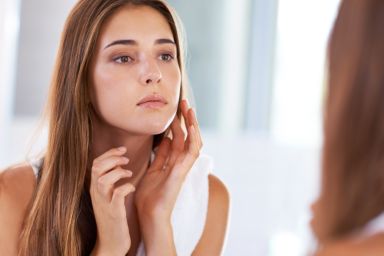
Causes of oily skin
- high-carbohydrate diet, i.e., an abundance of foods in the diet that increase insulin levels in the blood;
- lack of proper care, in particular insufficient exfoliation of the skin, as well as the use of comedogenic cosmetics;
- excessive insolation, aggravating hyperkeratosis, that is, thickening of the stratum corneum of the epidermis.
However, the question of why some people with oily skin develop blackheads and closed comedones, while others develop milia, remains open.
“This is likely due to the individual sebaceous gland response to the hormone, which is genetic in origin.”

If milia have already appeared on the face, they will not go away on their own - the formations may become less pronounced as a result of peeling and exfoliating activities. But this does not mean at all that the millet will not appear again. It all depends on the hormonal status, as well as nutrition and care.
In both children and adults, the formation of milia has hormonal causes. In newborns, milia go away on their own and without a trace. Adults will have to contact a specialist to get rid of millet.
If you are prone to the formation of blemishes (as well as comedones), you should take into account two factors that you yourself can influence: lifestyle and skin care.
We invite you to read: How to look younger than your age? Adviсe
Inadequately selected means can aggravate the situation and cause prosyanka. In particular, milia on the eyelids can appear as a result of the use of face creams in the periorbital area. It is useful to read articles on our website dedicated to caring for the skin around the eyes.
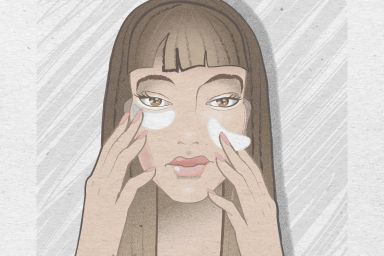
Caring for the skin around the eyes
Do not cleanse or degrease the skin too intensively, so as not to provoke its protective reaction in the form of hypersebony. The consequence may be the formation of milia.
You can't get rid of millet with the help of cosmetics, but we have made a selection of products that will provide competent care for skin prone to the formation of milia.
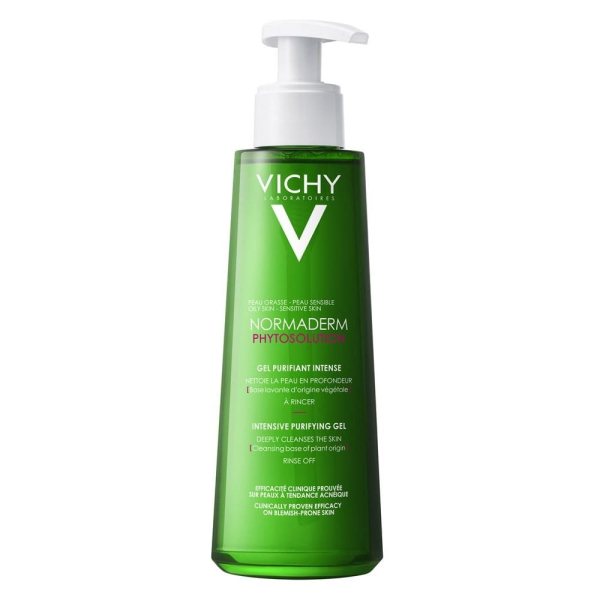
where to find?
Normaderm Phytosolution, Vichy cleansing gel with salicylic acid, a probiotic derivative and microelements eliminates impurities and excess sebum from the skin, and reduces the appearance of pores.
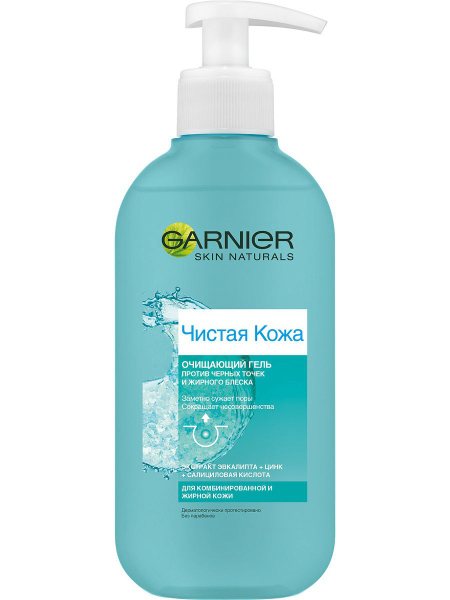
where to find?
Garnier Clear Skin Anti-Blackhead Cleansing Gel for oily skin contains salicylic acid and zinc to target imperfections.

where to find?
Pore tightening lotion Effaclar, La Roche-Posay with acids gradually and gently exfoliates dead cells, cleansing pores and reducing their size.
where to find?
Cleansing toner for skin against imperfections and signs of aging Blemish {amp}amp; Age Solution, SkinCeuticals with three types of acids provides gradual exfoliation of dead cells for renewed skin.
Scrubs and peelings
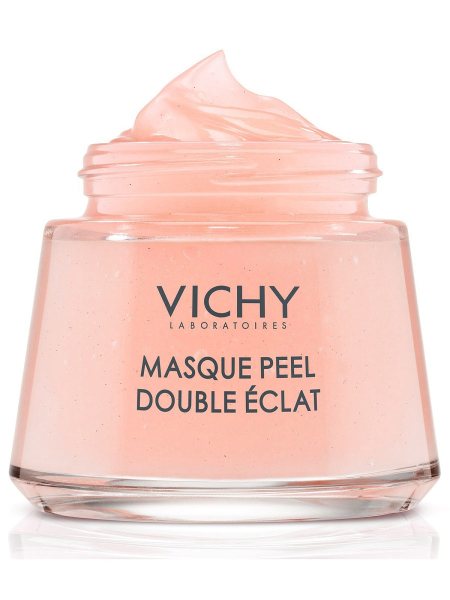
where to find?
Mineral peeling mask “Double Radiance”, Vichy - AHA acids and abrasive particles exfoliate dead cells, removing them from the skin.
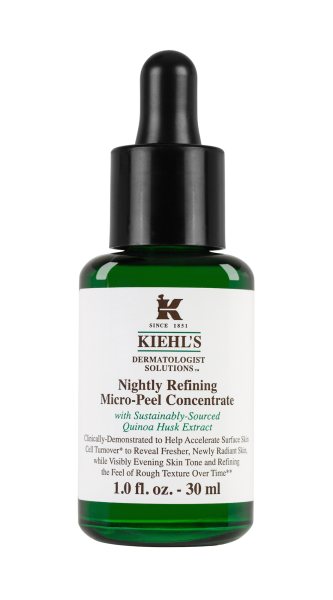
where to find?
Nightly Refining Micro-Peel Concentrate, Kiehl's, with a combination of several acids, works gradually and without aggression, helping to accelerate the natural process of skin cell renewal.
where to find?
Normaderm Phytosolution, Vichy double-action corrective care combines renewing properties with moisturizing and strengthening the skin's protective barrier.
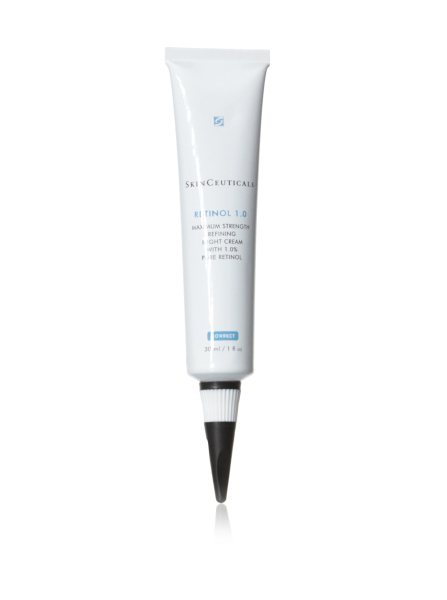
where to find?
Highly effective night cream Retinol 1.0, SkinCeuticals provides a pronounced anti-aging effect, reduces enlarged pores, contains pure encapsulated retinol (1%). This ingredient promotes exfoliation, which is very important for oily skin prone to hyperkeratosis.
where to find?
Corrective cream-gel for problem skin against imperfections and signs of post-acne Effaclar Duo (), La Roche-Posay exfoliates, including through a combination of lipohydroxy acid (LHA) and salicylic acid, and also moisturizes the skin for 24 hours.
Proper nutrition
Proper nutrition for oily skin is considered to be a diet that excludes high-carbohydrate foods: sugar, wheat, white rice and products made from them. The basis of the menu should be green vegetables, natural fats (both animal and vegetable, not refined), and proteins.
Preventive measures
If you want to restore your skin's attractiveness and smoothness, we recommend that you familiarize yourself with the tips listed below.
- Eating healthy foods. Avoid sweet, smoked, fried and salty foods, as well as alcohol and carbonated drinks.
- Correct implementation of necessary skin care procedures. Use those cosmetic products that suit the age, type and problems of your skin. It is important to properly cleanse the skin and provide it with adequate nutrition and hydration. To gently cleanse the epidermis, it is better to use homemade scrubs and masks.
- Skin protection in summer. You can protect the dermis from ultraviolet radiation with hats and sunscreen.
- Using high-quality and proven decorative cosmetics. Try to choose those products that are labeled “Hypoallergenic product”.
- Carrying out treatment of various diseases at the initial stage. This will have a positive effect on the health of the body and the appearance of your skin.
Now you know how to cure millet and prevent the occurrence of this dermatological disease in the future.
What remedies did you use to treat millet?
The fair sex is especially sensitive to their appearance. And if pimples, blackheads or other similar sores appear on the face, for women this problem immediately becomes of paramount importance. White dots that appear on the face require special attention. Millet or milia, despite the fact that they do not cause any discomfort, require urgent treatment. If such rashes are not cured immediately, then further methods of combating white pimples may not be effective.
What is millet
Millet is a dermatological disease that does not pose any danger to the body other than cosmetic discomfort. Whiteheads of a closed form, no more than 1 mm in size, can appear on the cheekbones, near the eyes and the T-zone (chin, forehead, nose). The structure of such formations bears little resemblance to ordinary acne. Some dermatologists are inclined to believe that millet is a wen that has arisen in the deep layers of the skin. Others compare milia to small cysts, due to the presence of a white bubble of dead, clogged skin cells (keratin) inside. In fact, as a result of numerous chemical studies, it has been confirmed that milia are not made of sebum, but of keratin. Therefore, millet cysts in official medicine are referred to as epidermal keratin cysts.
Due to the fact that the rashes do not contain any inflammatory foci, many women, and even men, do not pay any attention to them.
Reasons for the appearance of millet grass
Millet grains (the scientific name is closed comedones or milia) look like dense millet grains, which is why the rashes got their name. Medicine knows several important reasons for the appearance of milia:
- Maturation of baby's skin after birth. On the facial skin of newborns there are several white pimples that do not require any intervention, removal or squeezing. Pimples on a baby's face are normal; after some time they disappear on their own.
- Hormonal imbalance. Adolescence, menopause in women, pregnancy - all these periods are associated with the fact that an imbalance of sex hormones occurs in the human body.
- Problems of the gastrointestinal tract, liver and pancreas. Due to the fact that the skin is the largest human organ, any changes in their normal functioning are reflected in the appearance of the skin.
- Using low-quality cosmetics. Some women or girls may experience an allergic reaction in the form of white spots on the face. In this case, you should change cosmetics to more natural ones or not use them at all for a while.
- Prolonged exposure to the sun. Dermatologists have found that due to excessive exposure to UV rays, the skin becomes thicker and rougher, the cells cannot completely exfoliate and small wen-like lesions appear.
- Thyroid diseases. The endocrine system is the most vulnerable among all existing human organs, so its functioning should be closely monitored.
According to the method of occurrence, millet grains are divided into primary and secondary. Primary are pimples that suddenly appear and do not pose any danger. Such millet grains can appear in single quantities or as a rash, the main thing is that they disappear as unexpectedly as they appeared. Secondary milia occur on damaged skin, so they are often the result of an inflammatory process. By correctly determining the type of grass that occurs, you can most effectively and quickly overcome this problem.
To get rid of primary millet stains, you can visit a beauty salon. There, a special apparatus will be used to cleanse the face, i.e. will remove dead skin blisters from your skin. However, for many women this method is too expensive, so you can use home methods for getting rid of millet grass.
Using an insulin syringe. The first thing you need to do is prepare your facial skin. Clean it with special cosmetics and steam it over a hot infusion of herbs (this could be hypoallergenic chamomile). After your facial skin has become soft and your pores have opened, wipe your face with alcohol or any lotion based on it.
Attention! Procedures with a syringe or needle should be carried out only with perfectly clean, disinfected hands, so that no irritation occurs on the skin and inflammatory diseases do not begin.
Using a syringe, lightly pierce the white pimple right in the middle and carefully, using two fingers, squeeze out the contents of the vial. Usually what comes out is a dense, round, white structure. After the “mini operation” is performed, clean your face again with alcohol, paying special attention to the puncture site. After all procedures there should not be any discomfort. If you are experiencing some pain, you should visit a dermatologist.
It should be noted that folk remedies are less effective for getting rid of millet, but the overall condition of the facial skin improves significantly.
Viburnum juice and oatmeal
This mask is prepared immediately before application. You need to take half a glass of oatmeal or grind oatmeal, pour in freshly squeezed viburnum juice until you get the consistency of thick sour cream. Apply the mask to the skin of the face and leave for about 45-60 minutes, no less.
Steam facials
Very effective in combating small white rashes. Boil water in an enamel pan and add the medicinal herbs of sage, calendula or chamomile, let it brew for 15 minutes, covering the pan with a lid in advance. After this, sit on a chair, place the pan in front of you and place your face over the hot steam. The skin after such procedures becomes velvety and soft. This remedy is also preventive - the possibility of millet outbreaks is reduced several times.
Cucumber mask
Fresh cucumbers, after peeling and seeds, grate them and mix with boiling milk and water in a 1:1 ratio. After the mixture has been infused in a warm place for 30 minutes, you need to take a napkin made of natural fabric, make cutouts for the eyes and mouth, soak in the resulting solution and apply to the face. If you are suffering from millet rashes, then the mask should be applied daily; if for prevention, once a week is enough.
The area of skin under the eyes is the thinnest, so any independent squeezing is out of the question here. If you want to get rid of dark spots under your eyes, visit a dermatologist or beauty salon. They can use one of two methods - mechanical cleaning or darsonval (electric shock with talc). After the procedures, which are prescribed by a doctor and performed directly in the clinic, you will be offered a course of treatment with special cosmetics, which necessarily include salicylic acid, antibiotics, and so on.
Methods for treating rashes on the face in the salon and at home
This rash does not pose a health hazard, but does cause psychological discomfort. Doctors warn that you cannot remove this cosmetic defect yourself. It is advisable to treat it in a cosmetology salon.
You should consult a doctor if the rashes have not disappeared within six months. After examining the patient, the specialist prescribes therapy.
Removing millet grass
If there is a need to open the milium (cyst capsule), then this procedure should be carried out in a medical clinic. Previously, large formations were scraped out with a curette - a hook-shaped instrument that cleans out the millet from the inside. But at the moment, cosmetologists are abandoning this method, since it may leave scars on the skin.
An improved method is hardware removal of the cyst capsule, which can be performed using the following methods:
- laser;
- radio waves;
- electrocoagulation;
- vacuum or ultrasound cleaning;
- introduction of a solution that resolves milia.
In one procedure, it is possible to remove no more than 10 pimples, so it may take 4-5 sessions to completely get rid of the formations. If after these procedures a crust appears at the site of exposure, it is forbidden to tear it off. She'll go away on her own in a week.
The method used to remove grass moles depends on their location on the face, their depth, quantity, and size.
Often, millet grains are removed by squeezing. This method is mechanical and is performed using a thin sterile needle. The procedure is not simple, as the needle is inserted into the skin at a certain angle. The capsule is completely removed, but it is important not to damage its integrity. Afterwards peeling is carried out. The wound heals soon and leaves no traces.
You should avoid squeezing out pimples on your own, as this can lead to an inflammatory process with subsequent scarring of the skin.
Drug treatment
Sometimes millet grass is treated with medication: special gel preparations, ointments, creams that contain retinoids.
When treating millet weeds, it is necessary to avoid cosmetics or use non-comedogenic products for the face. Cosmetic procedures are also prohibited.

Folk remedies
Traditional medicine will help you get rid of blemishes on your face at home.
If the skin is prone to the appearance of grass, then it is useful to take steam baths based on medicinal herbs. Such plants include: calendula and chamomile flowers, sage.
Sour cream and pumpkin mask is an effective fighter against millet. Mix 15 g of fat sour cream and 20 g of pumpkin puree. Keep the mixture for 20 minutes.
Egg and honey mask is also an effective remedy for eliminating whiteheads. Take 1 egg and a tablespoon of natural honey. The ingredients are mixed until smooth and applied to the affected area. The action of the composition lasts for 20 minutes.
The cucumber mask is prepared as follows. Remove the skin from a fresh cucumber and grate it. Place the resulting mass in a bowl (glass, enamel) and pour in a mixture of hot milk and water, taken in equal quantities. Wrap the container with the cucumber mixture in a warm towel. Leave for at least 3 hours. Soak natural fabric with cutouts for the mouth and eyes in the cucumber mixture. Place the template on your face and hold for 15 minutes. For preventive purposes, this mixture should be applied to problem skin once a week. For the treatment of emerging grasses - daily.
Garlic helps achieve excellent results in the fight against milia. Add 2-3 cloves of chopped garlic to 30 ml of vegetable oil. Rub the composition into the problem area 3 times a day.
The golden mustache also has healing properties. The plant should be crushed, and the resulting pulp should be placed on gauze, then gently applied to the face for 1 hour.
Folk methods for eliminating blemishes on the face include the use of freshly squeezed viburnum juice, which is used to wipe problem skin as a preventive measure. A compress made from viburnum juice is considered beneficial. Soak a bandage in the healing liquid and apply to the skin for 10 minutes.
Viburnum mask with oatmeal fights existing “whiteheads”. Take oatmeal or grind oatmeal using a coffee grinder until it becomes powdery. Viburnum juice is added to the resulting flour. Everything is mixed (in an enamel or glass container) to the consistency of sour cream. This mask is applied to the skin of the face and left for 40–50 minutes. The finished mask cannot be stored, so it must be diluted immediately before use.
All of the above masks should be removed with warm water.
Traditional medicine does not provide a 100% guarantee of effectiveness, but it significantly improves the condition of the skin. They resort to it if it is not possible to visit the hospital.
Prevention measures
The main conditions for preventing millet infections are proper nutrition and daily skin care. It is useful to make masks, peeling, steam baths. Make clay masks weekly - they have a beneficial effect on the activity of the sebaceous glands, deliver all the necessary nutrients to the skin and cleanse it of dead cells.
You should also watch your diet. Avoid everything fried, floury and sweet. Even if you think that these products have no effect on the appearance of blemishes, you will be amazed at how healthy your skin will be in just a week. Additionally, you can take vitamins A and E or foods containing them.
Millet is not a dangerous disease. Cosmetic discomfort is what worries women primarily. When self-medicating, remember that if treated incorrectly, you can only worsen the situation by adding scars to your image. Preventive measures, which include proper nutrition and facial skin care, can protect you from all possible problems.
Video: how to get rid of milia
Millet grains, or milia, are small whitish formations on the skin, not exceeding 2-3 millimeters in diameter.
Their appearance is most often unexpected and, as a rule, does not cause pain or itching. But at the same time, the appearance of millet patches is accompanied by moral discomfort and aesthetic dissatisfaction, especially when it comes to exposed facial skin.
Why do blemishes appear on the face, how to protect yourself and get rid of them? These polls are answered today by the Beauty Pantry.
Getting rid of millet on the face using folk remedies
Since millet has appeared on the face for a long time, people have developed their own methods of treating it.
- Everyone knows the golden mustache plant. Having made a paste from its leaves, you should carry out the lotion procedure, preferably at night. Sometimes redness may occur, but a small formation will disappear, and a large one will become smaller in size. Treatment should last at least seven days.
- The next assistant is viburnum. Its juice mixed with potato starch is applied to the problem area for 30 minutes.
- The almighty garlic will not stand aside either. It must be crushed (one head) or crushed and mixed with olive oil or any unrefined sunflower oil. Rub the mixture several times throughout the day. You need to know that this method is not suitable for treating whiteheads around the lips and eyelids.
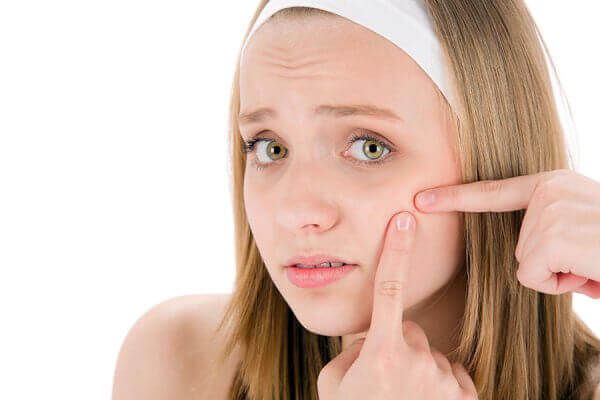
Why do blemishes appear on the face?
Let's start with the fact that millet grasses have a primary and secondary form. In the primary form, they appear in newborns, but are safe even during normal course and disappear on their own after a few weeks. Their formation in infants is explained by the accumulation of dead cells on the surface of the skin, the exfoliation of which does not occur in a timely manner. In the primary form, millet lesions affect only the face, and this is mainly the area around the eyes, forehead and nose.
The secondary form of millet grass is more dangerous. Milia in this case can appear on any area of the skin where there are sweat glands. And here, the cause of clogged sebaceous ducts can be not only dead cells, but also chronic skin diseases and other factors.
What causes secondary skin damage by millet grass? The answer to this question is not clear-cut. In most cases, it is due to improper cosmetic skin care and abuse of cleansers.
In addition, common causes of the appearance of millet grass include exposure to ultraviolet rays of a different nature, specifically skin diseases. Often, the secondary form of grass formation requires treatment under the supervision of a doctor, which is why it is so important to protect the skin from such a disease.
Milia, whiteheads, or someone who has spilled millet on their face?
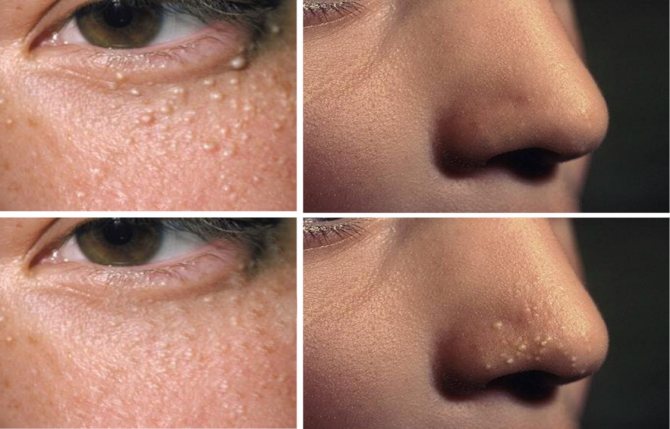
It is generally accepted that women experience skin problems only during adolescence, or at least during the premenstrual period. I mean now all kinds of pimples, blackheads and other decorations on women's faces. No matter how it is! There is such an unpleasant thing as whiteheads, they are also called milia, or in common parlance millet grains. For external resemblance. They not only affect teenagers, but also adults. It would seem that we don’t have enough wrinkles, cellulite, blackheads on the nose, problems with hair, and then there’s this! Well, okay, you can grumble as much as you want - this will not solve the problem. It is better to get to know this enemy better in order to know his weak points, which can be hit with all weapons. So let's get started!
What is milia
Milium is not a wen, as many people think. This is a kind of subcutaneous cyst, which is formed due to the proliferation of the epithelium. Inside it are keratinized cells of this same epithelium. The favorite habitat of whiteheads is the skin around the eyes, nose, and mouth area, although they can appear on any part of the body, including the genitals. They occur in both infants and adults. True, if for the former this is a variant of the norm, then for the latter, if they occur, they need to think about their health. Whiteheads are politically correct and do not discriminate by gender - they affect both men and women equally often!
But still, why do whiteheads suddenly grow? And this is the most interesting thing! Doctors and cosmetologists have no answer to this question! Like this! We are planning flights to Mars, but we cannot understand why whiteheads appear. Funny! However, doctors are trying to rehabilitate themselves in the eyes of an angry public, at least the fair half of it, and competently declare that there are factors that can trigger the development of milia.
Reasons contributing to the growth of millet
Firstly, there is an imbalance of sex hormones. This means that adolescents, pregnant women, and women during the period of hormonal changes in the body are at risk. Secondly, diseases of the thyroid gland and pancreas. And hormones again! Thirdly, unhealthy diet and diseases of the gastrointestinal tract. Less fatty, spicy and sweet, then whiteheads will have less chance. Those with oily skin are also unlucky - milia simply adore them! And yet, they can also appear from excessive exposure to ultraviolet radiation! Sunbathers need to remember this!
But all of the above is theory. But what about in practice? But in practice, it is better to remove milia! So as not to spoil the beauty. And if a single white eel is not a disaster, then those who have them forming whole clusters - and this happens - need to get rid of them! No creams, grandma's poultices, or other remedies will help! Deletion only. It is true that they say that viburnum juice helps to cope with whiteheads. Well, trying is not torture! It may help, but it seems to me that a professional cosmetologist will still be more helpful.
Home Resistance to Adversity
The removal procedure is simple, but it cannot be done at home, as it can cause infection. Here it is better to trust an experienced cosmetologist or dermatologist. The milium is pierced with a sterile needle, and its contents are squeezed out. There are other methods, but they all boil down to mechanical removal of whiteheads. The procedure of electrocoagulation is effective - milia are cauterized with electric current. You can try curettage - the cyst is opened, and its contents are removed with a special device, as if the cyst is cleaned from the inside. The easiest and most painless way is to remove whiteheads with a laser.
Read: Acne: causes, treatment, prevention
In general, it turns out that dealing with this scourge is quite easy. In principle, they are not dangerous to health; it is rather a cosmetic problem, which, however, can signal problems in the body. And one more question: how to prevent such beauty from reappearing. Here are the general recommendations:
- proper nutrition;
- proper skin care - scrubs, peelings, masks will reduce the likelihood of whiteheads;
- if you have diseases of the gastrointestinal tract or hormonal problems, a visit to the doctor is required;
- use of sunscreens;
- and, of course, the right way of life!
So the devil is not as scary as he is painted. And it’s still not worth making a catastrophe on a universal scale because of every white eel. Moreover, in the age of nanotechnology, everything (or almost everything) can be solved! There would be a desire!
(Visited 594 times, 1 visits today)
Read more
- How to deal with blackheads: effective tips
- Why does excess weight appear?
- What can our skin tell us?
Preventive measures to prevent secondary blemishes on the face
Remember that the condition of our skin largely depends on the lifestyle we choose and the products we consume. Therefore, to prevent millet infections, it is recommended to avoid consuming animal fats, sugar and alcohol.
At the local level, alcohol-containing cosmetics for the skin, as well as cosmetics containing petroleum jelly and saturated fats should be avoided.
But cosmetologists recommend exfoliating the skin at home with soft (gentle) scrubs once every 7-10 days. And in order to get rid of millet, you can use.
How to get rid of millet grass?
The best option for removing grasses is to visit a cosmetologist, who will solve this problem with the help of special medical instruments.
But not everyone finds the time and opportunity to visit a doctor, even a cosmetologist. And therefore, an alternative exists at home, which can be either more loyal or conservative.
- Honey mask to get rid of millet.
Several will allow you to cleanse the skin efficiently and carefully, while normalizing cellular metabolism. And this is the right path to clean and healthy skin.
Apply a thin layer of natural honey to cleansed skin, while gently massaging problem areas. After 10-15, the fingertips are dipped into warm water and the face is massaged again, lightly pressing and sharply removing the fingers from the face.
Finally, wash your face with warm water. If the honey you choose is too runny, you can mix it with a little oatmeal, which will also help cleanse your skin.
Home remedies for treating millet
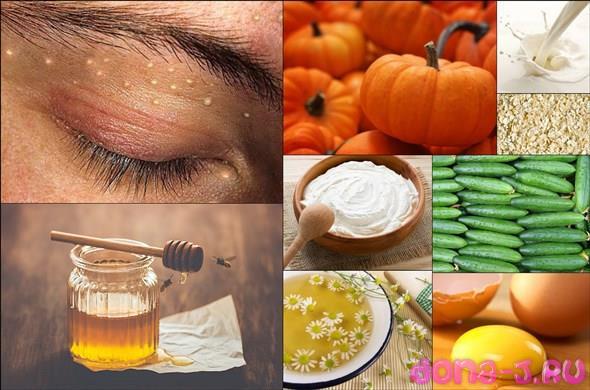
For home treatment of millet, you can use the following remedies:
- Compress with viburnum juice. Soak gauze or a piece of cloth in freshly squeezed juice from viburnum berries and apply to whiteheads. Keep it on for 15 minutes, then wash your face with filtered/settled/spring water.
- Cucumber milk compress. Turn the cucumber, cleared of seeds and peel, into a paste, put the mass in a deep bowl and fill it with milk and water (proportion – 1:1). After 4 hours, put gauze or a piece of cloth into a container and apply it to the acne for 20 minutes, after which we wash our face with filtered/settled/spring water.
- Golden mustache compress. Wash the leaves of the houseplant and grind them into a paste. We put the raw materials on the millet, fix the compress with gauze and adhesive tape. We keep the application on all night, in the morning we wash our face with filtered/settled/spring water.
- Milk-wheat compress. Turn wheat grains into flour and mix with milk. We put the thick mass in gauze or a bandage and apply it to the millet, securing the compress with an adhesive plaster. The action time of the components is 40 minutes, after which we wash our face with filtered/settled/spring water. We carry out the procedure twice a day.
- Chamomile compress with calendula. Pour 20 g of marigold and chamomile mixtures into a thermos with 0.5 liters of boiling water. After 5 hours, moisten the cotton pads in the warm infusion and apply them to the whiteheads for a quarter of an hour, constantly feeding the cotton wool with fresh infusion. Then we wash our face with filtered/settled/spring water. We repeat the procedure twice a day.
- Raspberry compress with a string. Pour 20 g of string and fresh raspberry leaves into a thermos with 0.5 liters of boiling water. After 40 minutes, moisten the cotton pads in the warm infusion and apply them to the whiteheads for 20 minutes, constantly feeding the cotton wool with fresh infusion. Then we wash our face with filtered/settled/spring water. We repeat the procedure twice a day.
- Mask with oatmeal and viburnum juice. Mix 15 ml of viburnum juice with oatmeal. We cover the millet with a thick mixture, after 45 minutes we wash off the composition with filtered/settled/spring water.
- Pumpkin mask with sour cream. Mix 20 g of pumpkin pulp with 15 g of homemade sour cream. Cover the whiteheads with the mixture and wait 15 minutes, rinse off the composition with filtered/settled/spring water.
- Mask with hydrogen peroxide and bodyaga. Mix 15 g of bodyaga (in powder) with peroxide. Cover the whiteheads with a thick mixture and wait 15 minutes. Wash off the mixture with filtered/settled/spring water.
- Egg-honey mixture. Mix fresh protein with 25 g of real honey. Apply the resulting mixture to the whiteheads and wait half an hour. Wash off the mixture with filtered/settled/spring water.
- Honey mask with yeast, hydrogen peroxide and lemon to dry the dermis after removing the millet. Mix 25 g of yeast with peroxide, lemon juice and real honey (20 g each). Apply a homogeneous mass to the whiteheads and wait half an hour. Wash off the mixture with filtered/settled/spring water.
- Honey mask. Apply fresh, uncandied honey to the millet, massage problem areas for 2 minutes and leave for another quarter of an hour. We wash off the honey with filtered/settled/spring water.
- Garlic oil ointment. Mix 30 g of garlic clove pulp with 30 ml of sunflower or olive oil. Rub the ointment into areas affected by whiteheads at least 5 times a day.
- Ointment made from onion juice and lamb fat. Add the same amount of onion juice to 50 g of melted fat. We treat the areas affected by millet with ointment 3 times a day.
- Lemon-grapefruit lotion with vodka. In 0.1 liter of juice obtained from ripe grapefruit, add 30 ml of lemon juice and 50 g of vodka. We keep the mixture in the refrigerator for 2 days, then use it as a lotion for wiping whiteheads.
Try to prepare each remedy listed, this is the only way you can find out which recipe is the most effective and safe for your face.
You can also perform mechanical facial cleansing to eliminate whiteheads at home . To do this, you will need a sterile needle, an antiseptic, medical gloves, a small piece of bandage and cotton wool. The technique for piercing whiteheads is given below.
- We steam the epidermis with a hot compress or herbal bath.
- We put on gloves, process the needle and begin the procedure.
- We stretch the skin and make a puncture in the middle of the eel. Squeeze the contents onto a bandage. We wipe the dermis with a cotton wool soaked in antiseptic.
- We repeat the described steps for each individual eel.
In addition, you can use store-bought ointments at home. The most famous are Differin, Zerkalin and Zovirax.
How to remove blemishes on the face
Removing millet grass at home is not the best method... but still, if you decide to get rid of millet grass yourself, do not forget about cleanliness and disinfection.
Before the procedure, the face must be cleaned and steamed over a steam bath with soda or herbs, and hands must be thoroughly washed and wiped with alcohol. And then use a cosmetic needle (or an insulin needle) to pierce the millet directly in the center at an angle of 90°.
If the millet is sufficiently ripe, its contents will easily come out. When experimenting with self-removal of grass, do not forget about the possible negative consequences (scars, bumps on the skin or infection).
Aloe as a homemade cosmetic product.
To treat millet, prepare a gauze mask soaked in aloe juice and lemon and apply it to your face for half an hour. You should use aloe masks every day for the first 2 weeks, and then 3 times a week until the millet is completely removed from the face. Total for effective removal you should take a course of 30 - 40 similar masks.
Add a clove of garlic at least once with meals. By using such a powerful antibacterial natural preparation, you will treat millet from the inside of the body, treating the root causes of its appearance.
In folk medicine, millet grass was treated at home using a paraffin mask, which was melted and applied to the sites of formation of even very small millet lesions in two layers, after which the paraffin on the skin took the form of a film.
For home treatment of millet grains, pre-frozen cubes of chamomile or bird cherry decoction are also useful, which you should keep on the affected skin of the face until they part.
If you want to get rid of and completely remove millet from your face as quickly as possible, then you can seek help from beauty salons that provide vacuum or mechanical facial cleansing services.
